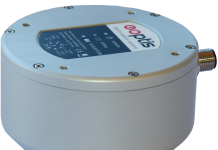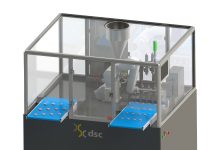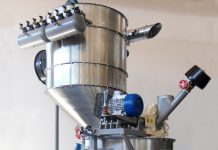by Giuseppe Ciccarone
Depending on their production capacity and product formats, the production lines of dried pasta that use static drying require a variable number of operators. The need concerns process management with particular reference to the production program and quality, the management of the formats’ change, the handling of pasta along the entire path, from dough processing to packaging and storage. Analyzing the path of produced pasta, from its die to its exit from the static dryer we wondered what solutions can be implemented to automate some steps and allow operators to devote more time to process management and quality, so to allow them being less busy with the simple management of rods or frames. We will analyze some of the most used and interesting ones. But what difference is there between automation and continuous process? To avoid frequent confusion it should be noted that automation refers to individual phases or consecutive stages: this is the case of automatic dough groups which, without any intervention if not at the start, allow dosing, pre-mixing and kneading different ingredients according to recipes defined and managed by PLC. The production lines of statically dried pasta are characterized by a strong discontinuity component; as a matter of fact they provide for operators’ intense activity along the process that is literally “chopped” into distinguishable phases. For example, it may happen that if the rods with the stretched pasta fill the cart, the operator has to interrupt production in order to replace, with an empty cart, the rods stockpile and also to lead the cart in the drying chamber. In this case we are certainly speaking about a discontinuous process that can be automated in some phases, with the result of making it “partially automated”. Before describing the main automations we wonder what should be the main feature in support of their choice: it must require less supervision and control by operators who will appreciate it as much as its use will be intuitive, and should also be easy to understand and apply. The pasta factory will draw benefits such as: improvement of production time and format change, reduced downtime, simplification of the production program, or simply: “simplification” and “cost reduction”. The analyzed systems are pretty different depending on the type of pasta made on the line: short or long; this is because automatisms differ greatly, based on whether pasta frames or rods have to be moved. These are obviously different because they change the approaches and results obtained by the companies in the sector.
Short pasta
 Feeder for short pasta frames: at the end of the process short pasta needs to be pre-dried superficially by a shaker; in the simplest case after a variable number of passages the pasta falls on the frames and is arranged in an almost uniform way by the operator, which periodically moves the filled frames on the cart; in this way he forms and completes the cart that will be placed in the drying chamber. More modern lines are equipped with frame transport systems starting from the frame feeder: a tray of empty frames moves on a trail and after passing through a special shaker, it receives the pasta. The operator, therefore, must only place and replace periodically the tray in the specific safety cage. At the end of the line the automatic options that allow stacking frames on the carts are mainly two. The former is the stacker for frames that consists of a chain system which raises the frame with pasta and moves it just above the cart and, as the frames arrive, it allows their stacking. An alarm warns the operator to pull out the cart with the frames intended for the drying chamber, reinserting another empty cart in the safety structure (in steel mesh or plexiglass). The other solution is more advanced and automatic: it consists of a robot for frames which is very similar to that provided for the start line but featuring a reverse logic: it fetches a predetermined number of frames from an end of line accumulator and places them on the cart. The accumulation system also has the task of serving as buffer storage in the time devoted to replace the carts, in order to avoid downtime. In the packaging department short pasta which is packed with automatic packaging machines is usually discharged into the feed hopper manually: the operator takes a frame and empties its. For this stage, it is possible to opt for a robot that discharges and positions the empty frames to form the cart; the latter will be brought at the beginning of each line and every frame will come into the production circuit.
Feeder for short pasta frames: at the end of the process short pasta needs to be pre-dried superficially by a shaker; in the simplest case after a variable number of passages the pasta falls on the frames and is arranged in an almost uniform way by the operator, which periodically moves the filled frames on the cart; in this way he forms and completes the cart that will be placed in the drying chamber. More modern lines are equipped with frame transport systems starting from the frame feeder: a tray of empty frames moves on a trail and after passing through a special shaker, it receives the pasta. The operator, therefore, must only place and replace periodically the tray in the specific safety cage. At the end of the line the automatic options that allow stacking frames on the carts are mainly two. The former is the stacker for frames that consists of a chain system which raises the frame with pasta and moves it just above the cart and, as the frames arrive, it allows their stacking. An alarm warns the operator to pull out the cart with the frames intended for the drying chamber, reinserting another empty cart in the safety structure (in steel mesh or plexiglass). The other solution is more advanced and automatic: it consists of a robot for frames which is very similar to that provided for the start line but featuring a reverse logic: it fetches a predetermined number of frames from an end of line accumulator and places them on the cart. The accumulation system also has the task of serving as buffer storage in the time devoted to replace the carts, in order to avoid downtime. In the packaging department short pasta which is packed with automatic packaging machines is usually discharged into the feed hopper manually: the operator takes a frame and empties its. For this stage, it is possible to opt for a robot that discharges and positions the empty frames to form the cart; the latter will be brought at the beginning of each line and every frame will come into the production circuit.




